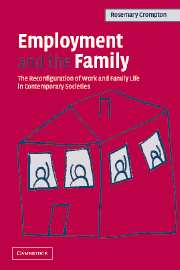Book contents
- Frontmatter
- Contents
- Preface
- 1 Understanding change in employment, family and gender relations
- 2 Caring and working
- 3 Women, men, organisations and careers
- 4 Work–life articulation, working hours and work–life policies
- 5 States, families and work–life articulation
- 6 Households, domestic work, market work and happiness
- 7 Class, family choices and women's employment
- 8 Conclusions
- Appendix A Additional ISSP Family 2002 questions
- Appendix B Joseph Rowntree Foundation (JRF) interviewees cited
- Bibliography
- Index
3 - Women, men, organisations and careers
Published online by Cambridge University Press: 22 September 2009
- Frontmatter
- Contents
- Preface
- 1 Understanding change in employment, family and gender relations
- 2 Caring and working
- 3 Women, men, organisations and careers
- 4 Work–life articulation, working hours and work–life policies
- 5 States, families and work–life articulation
- 6 Households, domestic work, market work and happiness
- 7 Class, family choices and women's employment
- 8 Conclusions
- Appendix A Additional ISSP Family 2002 questions
- Appendix B Joseph Rowntree Foundation (JRF) interviewees cited
- Bibliography
- Index
Summary
Changes in employment
In this chapter, our main focus will be on the changes in the world of work (as employment) that have already been briefly introduced in Chapter 1. As we have seen, the stereotypical organisation of the Fordist era was large in scale and bureaucratic in its organisation, male dominated in its employees, uniform in its products and ‘deskilled’ in its work organisation. In manufacturing, the motor industry was seen as the exemplar of these trends (Beynon 1973; Blauner 1964; Braverman 1974). However, from the 1970s onwards, the pace of technological change, together with new forms of work organisation, generated an increasing flow of commentaries suggesting that the nature of employment was changing irrevocably. In The Future of Work (1984), Handy described a future in which large organisations became increasingly flexible as, following the Japanese model, they subcontracted and outsourced an increasing number of operations, manufacturing jobs were lost as a consequence of technological change, and low-level service (rather than manufacturing) work proliferated. He was writing at a time of rising unemployment, that (at the time) was thought by many as likely to become a more or less permanent state of affairs. Ten years later, Handy (1994) was describing the advent of the ‘portfolio’ career that would become the norm in the newly emerging, flexible, labour market. Individuals, he argued, would no longer depend on a single organisation in order to develop a career, but would move from job to job as they ‘self-developed’ their career trajectories.
- Type
- Chapter
- Information
- Employment and the FamilyThe Reconfiguration of Work and Family Life in Contemporary Societies, pp. 62 - 88Publisher: Cambridge University PressPrint publication year: 2006



